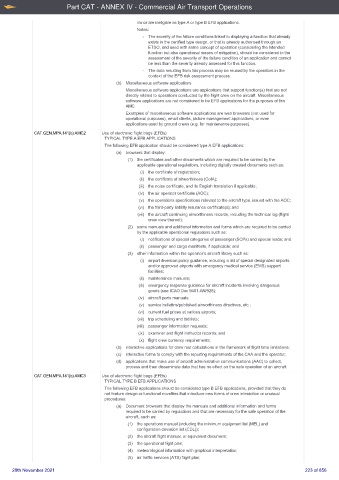Page 223 - UK Air Operations Regulations 201121
P. 223
Part CAT - ANNEX IV - Commercial Air Transport Operations
minor are ineligible as type A or type B EFB applications.
Notes:
- The severity of the failure conditions linked to displaying a function that already
exists in the certified type design, or that is already authorised through an
ETSO, and used with same concept of operation (considering the intended
function but also operational means of mitigation), should be considered in the
assessment of the severity of the failure condition of an application and cannot
be less than the severity already assessed for this function.
- The data resulting from this process may be reused by the operators in the
context of the EFB risk assessment process.
(b) Miscellaneous software applications
Miscellaneous software applications are applications that support function(s) that are not
directly related to operations conducted by the flight crew on the aircraft. Miscellaneous
software applications are not considered to be EFB applications for the purposes of this
AMC.
Examples of miscellaneous software applications are web browsers (not used for
operational purposes), email clients, picture management applications, or even
applications used by ground crews (e.g. for maintenance purposes).
CAT.GEN.MPA.141(b) AMC2 Use of electronic flight bags (EFBs)
TYPICAL TYPE A EFB APPLICATIONS
The following EFB application should be considered type A EFB applications:
(a) browsers that display:
(1) the certificates and other documents which are required to be carried by the
applicable operational regulations, including digitally created documents such as:
(i) the certificate of registration;
(ii) the certificate of airworthiness (CofA);
(iii) the noise certificate, and its English translation if applicable;
(iv) the air operator certificate (AOC);
(v) the operations specifications relevant to the aircraft type, issued with the AOC;
(vi) the third-party liability insurance certificate(s); and
(vii) the aircraft continuing airworthiness records, including the technical log (flight
crew view thereof);
(2) some manuals and additional information and forms which are required to be carried
by the applicable operational regulations such as:
(i) notifications of special categories of passenger (SCPs) and special loads; and
(ii) passenger and cargo manifests, if applicable; and
(3) other information within the operator’s aircraft library such as:
(i) airport diversion policy guidance, including a list of special designated airports
and/or approved airports with emergency medical service (EMS) support
facilities;
(ii) maintenance manuals;
(iii) emergency response guidance for aircraft incidents involving dangerous
goods (see ICAO Doc 9481-AN/928);
(iv) aircraft parts manuals;
(v) service bulletins/published airworthiness directives, etc.;
(vi) current fuel prices at various airports;
(vii) trip scheduling and bid lists;
(viii) passenger information requests;
(ix) examiner and flight instructor records; and
(x) flight crew currency requirements;
(b) interactive applications for crew rest calculations in the framework of flight time limitations;
(c) interactive forms to comply with the reporting requirements of the CAA and the operator;
(d) applications that make use of aircraft administrative communications (AAC) to collect,
process and then disseminate data that has no effect on the safe operation of an aircraft.
CAT.GEN.MPA.141(b) AMC3 Use of electronic flight bags (EFBs)
TYPICAL TYPE B EFB APPLICATIONS
The following EFB applications should be considered type B EFB applications, provided that they do
not feature design or functional novelties that introduce new forms of crew interaction or unusual
procedures:
(a) Document browsers that display the manuals and additional information and forms
required to be carried by regulations and that are necessary for the safe operation of the
aircraft, such as:
(1) the operations manual (including the minimum equipment list (MEL) and
configuration deviation list (CDL));
(2) the aircraft flight manual, or equivalent document;
(3) the operational flight plan;
(4) meteorological information with graphical interpretation;
(5) air traffic services (ATS) flight plan;
20th November 2021 223 of 856

